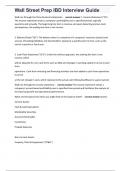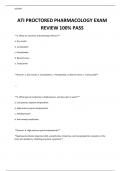Wall Street Prep IBD Interview Guide
Walk me through the three financial statements. - correct answer 1. Income Statement ("IS"):
The income statement shows a company's profitability over a specified period, typically
quarterly and annually. The beginning line item is revenue and upon deducting various costs
and expenses, the ending line item is net income.
2. Balance Sheet ("BS"): The balance sheet is a snapshot of a company's resources (assets) and
sources of funding (liabilities and shareholders' equity) at a specific point in time, such as the
end of a quarter or fiscal year.
3. Cash Flow Statement ("CFS"): Under the indirect approach, the starting line item is net
income, which
will be adjusted for non-cash items such as D&A and changes in working capital to arrive at cash
from
operations. Cash from investing and financing activities are then added to cash from operations
to arrive
at the net change in cash, which represents the actual cash inflows/(outflows) in a given period.
Walk me through the income statement. - correct answer The income statement shows a
company's accrual-based profitability over a specified time period and facilitates the analysis of
its historical growth and operational performance.
What are the typical line items you might find on the balance sheet? - correct answer Assets:
Current Assets:
Cash & Cash Equivalents
Marketable Securities
Accounts Receivable
Inventories
Prepaid Expenses
Non-Current Assets:
Property, Plant & Equipment ("PP&E")
,Wall Street Prep IBD Interview Guide
Intangible Assets
Goodwill
Liabilities:
Current Liabilities:
Accounts Payable
Accrued Expenses
Short-Term Debt
Non-Current Liabilities:
Deferred Revenue
Deferred Taxes
Long-Term Debt
Lease Obligations
Shareholder's Equity:
Common Stock
Additional Paid-In Capital ("APIC")
Preferred Stock
Treasury Stock
Retained Earnings (or Accumulated Deficit)
Other Comprehensive Income ("OCI")
On the Balance Sheet, what are Cash and Cash Equivalents (Current Asset)? - correct answer
This line item includes cash itself and highly liquid, cash-like investments, such as commercial
paper and short-term government bonds.
,Wall Street Prep IBD Interview Guide
On the Balance Sheet, what are Marketable Securities (Current Asset)? - correct answer
Marketable securities are short-term debt or equity securities held by the company that can be
liquidated to cash relatively quickly.
On the Balance Sheet, what are Accounts Receivable (Current Asset)? - correct answer A/R
refers to payments owed to a business by its customers for products and services already
delivered to them (i.e. an "IOU" from the customer).
On the Balance Sheet, what are Inventories (Current Asset)? - correct answer Inventories are
raw materials, unfinished goods, and finished goods waiting to be sold and the direct costs
associated with producing those goods.
On the Balance Sheet, what are Prepaid Expenses (Current Asset)? - correct answer Prepaid
expenses are payments made in advance for goods or services expected to be provided on a
later date, such as utilities, insurance, and rent.
On the Balance Sheet, what are Property, Plant & Equipment ("PP&E") (Non-Current Asset)? -
correct answer The fixed assets such as land, buildings, vehicles, and machinery used to
manufacture or provide the company's services and products.
On the Balance Sheet, what are Intangible Assets (Non-Current Asset)? - correct answer
Intangible assets are non-physical, acquired assets such as patents, trademarks, and intellectual
property ("IP").
On the Balance Sheet, what is Goodwill (Non-Current Asset)? - correct answer An intangible
asset created to capture the excess of the purchase price over the fair market value ("FMV") of
an acquired asset.
On the Balance Sheet, what is Accounts Payable (Current Liability)? - correct answer A/P
represents unpaid bills to suppliers and vendors for services/products already received but
were paid for on credit.
On the Balance Sheet, what is Accrued Expenses (Current Liability)? - correct answer Accrued
expenses are incurred expenses such as employee compensation or utilities that have not been
paid, often due to the invoice not being received.
On the Balance Sheet, what is Short-Term Debt (Current Liability)? - correct answer Debt
payments coming due within twelve months, with the current portion of long-term debt also
included.
On the Balance Sheet, what is Deferred Revenue (Non-Current Liability)? - correct answer
Unearned revenue received in advance for goods or services not yet delivered to the customer
(can be either current or non-current).
, Wall Street Prep IBD Interview Guide
On the Balance Sheet, what is Deferred Taxes (Non-Current Liability)? - correct answer Tax
expense recognized under GAAP but not yet paid because of temporary timing differences
between book and tax accounting.
On the Balance Sheet, what is Long-Term Debt (Non-Current Liability)? - correct answer Long-
term debt is any debt capital with a maturity exceeding twelve months.
On the Balance Sheet, what is Lease obligations (Non-Current Liability)? - correct answer
Leases are long-term contractual agreements, allowing a company to lease PP&E for a specific
time period in exchange for regular payments.
On the Balance Sheet, what are Common Stock (Shareholder's Equity)? - correct answer
Common stock represents a share of ownership in a company and can be issued when raising
capital from outside investors in exchange for equity
On the Balance Sheet, what are Additional Paid-In Capital ("APIC") (Shareholder's Equity)? -
correct answer APIC represents the amount received in excess over the par value from the sale
of preferred or common stock.
On the Balance Sheet, what are Preferred Stock (Shareholder's Equity)? - correct answer
Preferred stock is a form of equity often considered a hybrid investment, as it has features of
both common stock and debt.
On the Balance Sheet, what are Treasury Stock (Shareholder's Equity)? - correct answer Refers
to shares that had been previously issued but were repurchased by the company in a share
buyback and are no longer available to be traded.
On the Balance Sheet, what are Retained Earnings (or Accumulated Deficit) (Shareholder's
Equity)? - correct answer Represents the cumulative amount of earnings since the company
was formed, less any dividends paid out.
On the Balance Sheet, what are Other Comprehensive Income ("OCI") (Shareholder's Equity)? -
correct answer OCI consists of foreign currency translation adjustments and unrealized gains or
losses on available-for-sale securities.
Walk me through the cash flow statement. - correct answer There are two methods by which
cash flow statements are organized: Direct and Indirect.
The more common approach is the indirect method, whereby the cash flow statement is
broken out into three sections:





